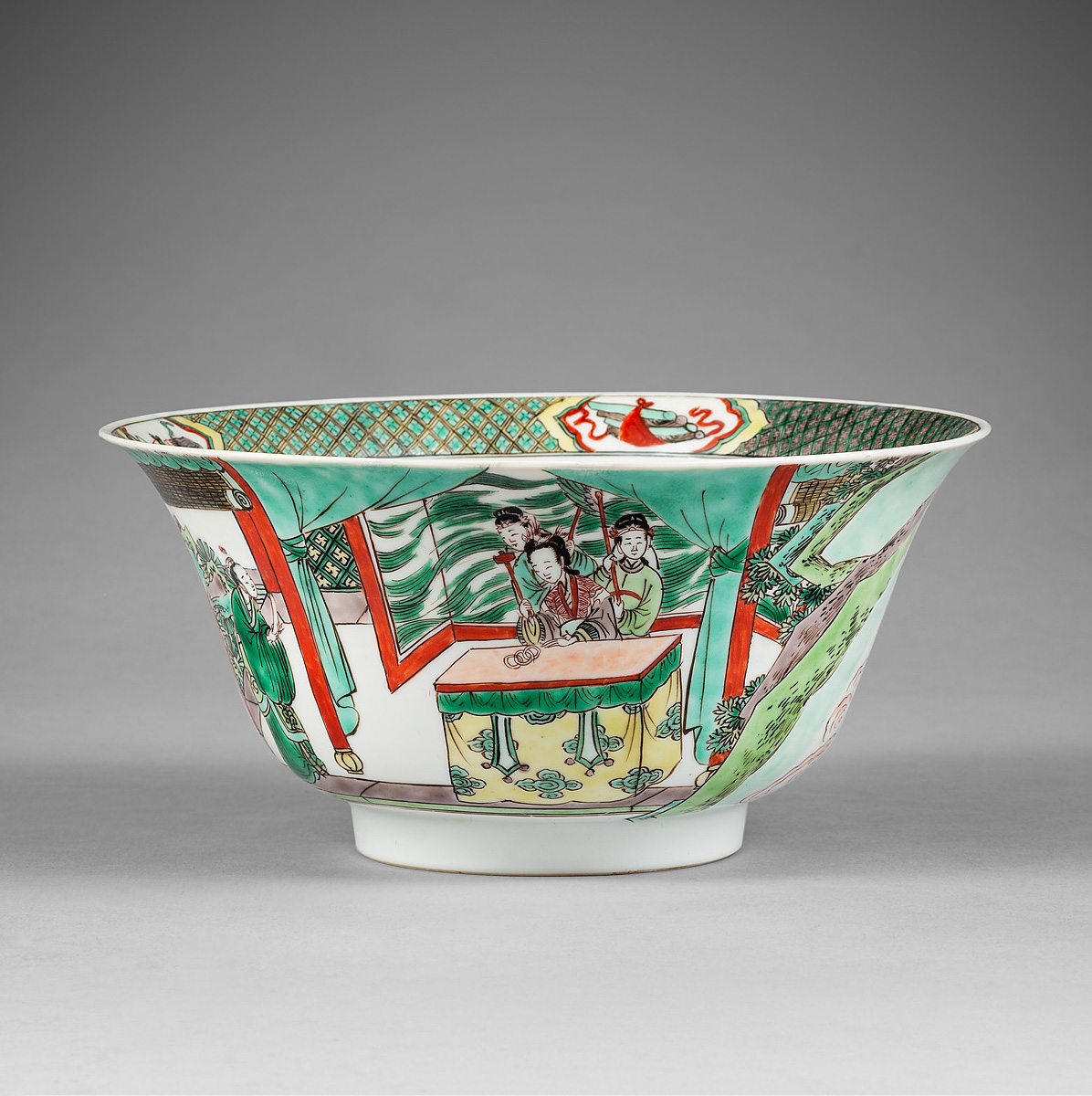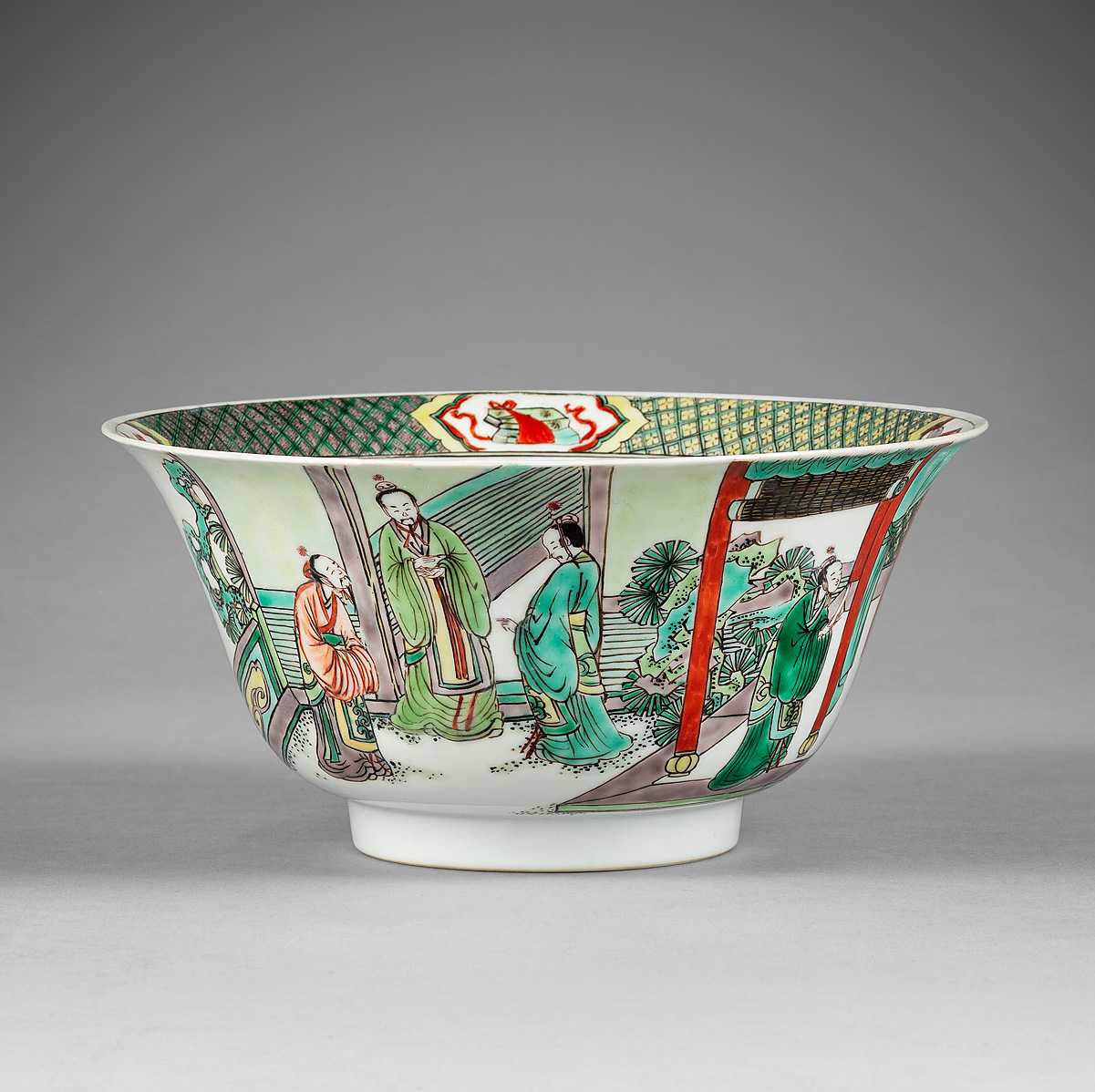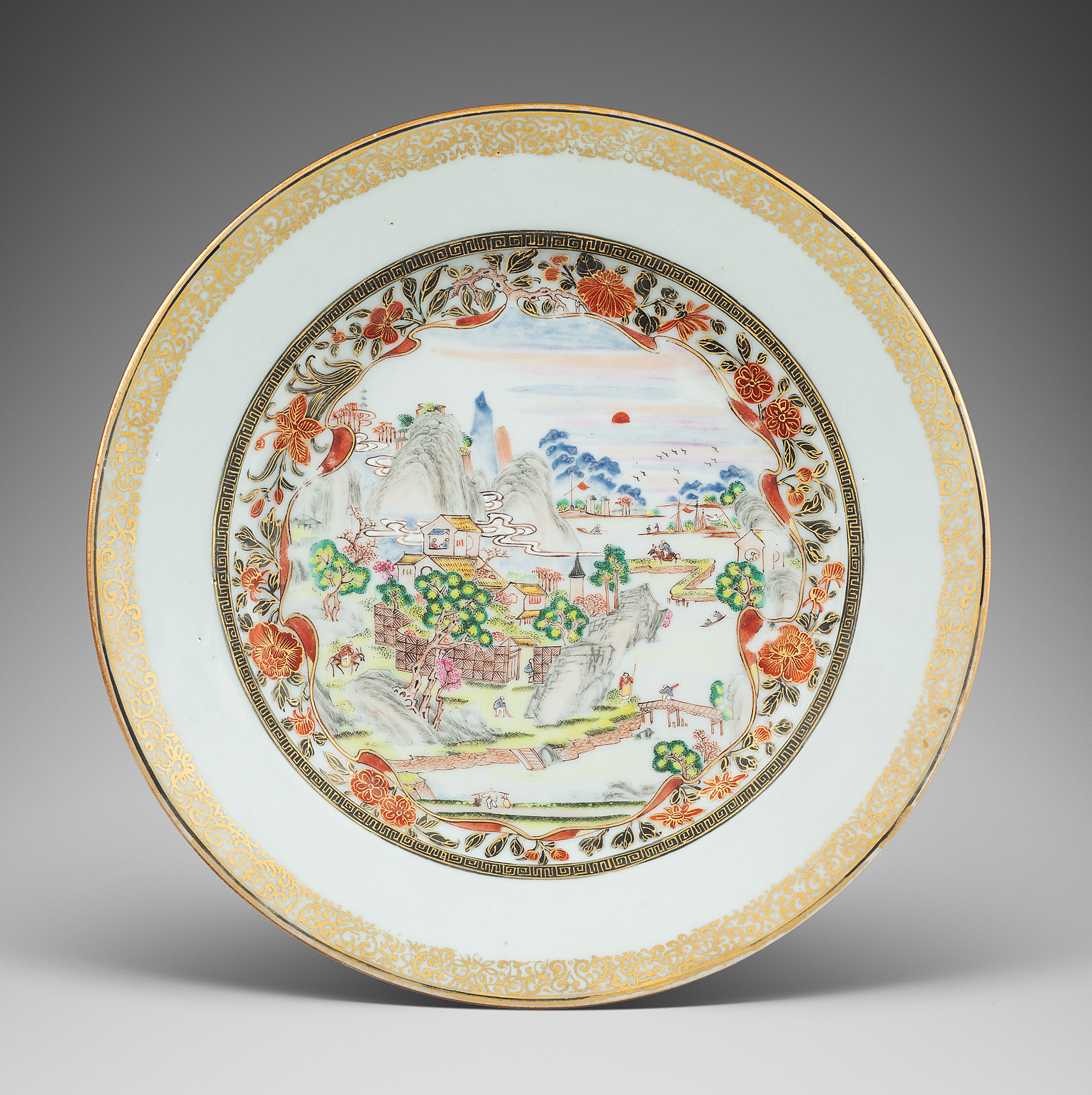

The famille verte “Imperial consort Lady Yang” bowl of Octave du Sartel (1823-1894). Kangxi period
Of a very hight quality of painting, and depicting the Imperial consort Lady Yang smashing her bracelet with a hammer at the Hundred Flowers Pavilion, with two maids next to her. On the other side of the bowl are depicting three figures, possibly three generals or the Emperor Xuanzong of Tang. The back of the bowl with a Chenghua apocryphal mark.
Bowl of this quality are rare, especially without blue enamel on the painting.
- Country:
- China
- Period :
- Kangxi (1662-1722), ca. 1680/1690
- Material:
- Porcelain
- Dimension:
- 7.67 in. (19.5 cm)
- Reference :
- D953
- Status:
- sold
Provenance
-Octave du Sartel (1823-1894)
-His sale, Porcelaines de la Chine et du Japon composant la collection de M. O. du Sartel, Hotel Drouot, 3/5 april 1882, lot 208
Related works
About Octave du Sartel and some pieces of his collection exhibited recently, see Pauline d’Abrigeon, Pauline Guyot et Catherine Tran-Bourdonneau, À portée d’Asie. Collectionneurs, collecteurs et marchands d’art asiatique en France – 1750 – 1930, Institut national d’histoire de l’art/Musée des Beaux-Arts de Dijon/Liernart, 2023.
For two bowls of a very similar quality (with blue enamels and without Chenghua mark), see the Dresden Collection, inventory number PO 3648 / PO 3649.
For another bowl from the Butler collection, of similar quality (with blue enamels and without chenghua mark), see Christie’s HK, Important Chinese Ceramics and works of Art, 29 November 2022, lot 2659.
For a covered bowl without blue enamel, from the Kangxi period (1662-1722) and bearing a Chenghua mark, see Sotheby’s NYC, Kangxi: The Jui Tang collection, 2018, lot 364 (a famille verte “crane” bowl and cover).
Notice
The play Polishing the Dust-covered Mirror was compiled in 1619 by an obscure playwright Niu Ge, according to some twentieth-century researchers, including the eminent scholar of the field Zheng Zhenduo (1898–1958). The play portrays some colourful historical figures of the Tang dynasty (618–907) such as Emperor Xuanzong of Tang (685–762) and his famous consort Lady Yang Yuhuan (719–56), one of the Four Great Classic Beauties in Ancient China.
In Act 12, entitled ‘The Tipsy Consort ( Zui Fei)’, Lady Yang had an appointment with Emperor to attend a banquet at Baihua Pavilion, but after waiting for a long time, he didn’t arrive. The Emperor fails to turn up at the Hundred Flowers Pavilion, where they are supposed to meet that evening. Later, she found out that he had already transferred to the West Palace. She was so ashamed and angry that she smashed her bracelet with a hammer to vent her anger.
Octave du Sartel (1823-1894)
By Pauline d’Abrigeon (trad. Jennifer Donnelly), « Sartel, Octave du », in Institut National d’Histoire de l’Art (éd.), Collectionneurs, collecteurs et marchands d’art asiatique en France 1700-1939, [en ligne] 2022.
Octave Charles Waldemar Frémin du Sartel was born on January 6, 1828 in Douai in northern France (AN, LH 1033 35 p. 5). The third child of Jean-Philippe Frémin du Sartel (1792-1864) and Eugénie Joséphine Adelaïde de Carondelet (1791-1855), his brothers and sisters were Adèle Cornélie (1815-1902), Jean Philippe Eugène Léon (1817-1881), and Marie-Charlotte (1829-1900). His grandfather, Jean-Philippe Frémin du Sartel, was lord of Quesnines, Baratte, Sart-le-Sartel, and alderman of Cambrai. His father was bodyguard to King Louis XVIII and Knight of the Legion of Honor (AN, LH/1033/34). His mother, daughter of Messire François, Viscount of Carondelet (1759-1807) and Angélique de Turpin-Crissé (1765-1835), came from the prestigious Carondelet family, originally from Bresse and settled mainly in Burgundy, where, during the Renaissance, several members of the family distinguished themselves as prelates and patrons of the arts and letters. She was also the direct descendant of Marshal Ulrich Frédérique Woldemar de Lowendal (1700-1755), Knight of the Order of the Holy Spirit. It is likely this refined and artistic background that inspired Octave du Sartel with a vocation for collecting and a full commitment to the artistic circles of his time.
His career in the Navy seemed clearly charted. At only eleven years old, he entered the naval school, and three years later, in 1841, he became a midshipman in the port of Brest. According to his Legion of Honour file, he participated in the capture of the Marquesas Islands and the annexation of Tahiti aboard the Triomphante under the command of Abel Aubert Dupetit-Thouars (1793-1864). He was appointed ensign starting November 1, 1845. However, after only two years of service, he resigned on January 20, 1847, a few days after his marriage.
He was married in Brussels on January 12, 1847 to Mathilde Marie van Alstein (1823-1883), originally from Ghent. From their union were born three children: Georges Jean Philippe Waldemar Frémin du Sartel (1848-1904), Marie Mathilde Antoinette Frémin du Sartel (1849-1919) and Gaston Léon Jean Frémin du Sartel (died August 2, 1885). The family resided at 18 rue Lafayette. Octave du Sartel became known for his work on Chinese porcelain by publishing the first monograph in French language on the subject in 1881. He had a significant collection of art works which would be dispersed during two sales in the second half of the 19th century.
Octave Charles Waldemar Frémin du Sartel was born on January 6, 1828 in Douai in northern France (AN, LH 1033 35 p. 5). The third child of Jean-Philippe Frémin du Sartel (1792-1864) and Eugénie Joséphine Adelaïde de Carondelet (1791-1855), his brothers and sisters were Adèle Cornélie (1815-1902), Jean Philippe Eugène Léon (1817-1881), and Marie-Charlotte (1829-1900). His grandfather, Jean-Philippe Frémin du Sartel, was lord of Quesnines, Baratte, Sart-le-Sartel, and alderman of Cambrai. His father was bodyguard to King Louis XVIII and Knight of the Legion of Honor (AN, LH/1033/34). His mother, daughter of Messire François, Viscount of Carondelet (1759-1807) and Angélique de Turpin-Crissé (1765-1835), came from the prestigious Carondelet family, originally from Bresse and settled mainly in Burgundy, where, during the Renaissance, several members of the family distinguished themselves as prelates and patrons of the arts and letters. She was also the direct descendant of Marshal Ulrich Frédérique Woldemar de Lowendal (1700-1755), Knight of the Order of the Holy Spirit. It is likely this refined and artistic background that inspired Octave du Sartel with a vocation for collecting and a full commitment to the artistic circles of his time.
His career in the Navy seemed clearly charted. At only eleven years old, he entered the naval school, and three years later, in 1841, he became a midshipman in the port of Brest. According to his Legion of Honour file, he participated in the capture of the Marquesas Islands and the annexation of Tahiti aboard the Triomphante under the command of Abel Aubert Dupetit-Thouars (1793-1864). He was appointed ensign starting November 1, 1845. However, after only two years of service, he resigned on January 20, 1847, a few days after his marriage. He was married in Brussels on January 12, 1847 to Mathilde Marie van Alstein (1823-1883), originally from Ghent. From their union were born three children: Georges Jean Philippe Waldemar Frémin du Sartel (1848-1904), Marie Mathilde Antoinette Frémin du Sartel (1849-1919) and Gaston Léon Jean Frémin du Sartel (died August 2, 1885). The family resided at 18 rue Lafayette.
There followed a long period between the beginning of the 1850s and the end of the 1870s during which little information is available regarding his activities. On March 15, 1862, he joined Adolphe Brudenne, a manufacturer of stearin (a material used in the manufacture of candles), along with the Counts Joseph Erard and Ernest de la Vaulx to form a company dedicated to the manufacture of stearin and the sale of its products, called “Société de stéarinerie Brudenne” (Madre, 1862, np). It was a family venture, Count Érard de La Vaulx being the husband of Octave du Sartel’s older sister. The company took the name of P.-P. Marin et Compagnie when Philippe Marin bought the shares of Adolphe Brudenne. It was under this name that it was dissolved in 1866, and Octave du Sartel was named its liquidator (Hèvre, 1866, n.p.). Octave du Sartel undoubtedly pursued other commercial activities of this sort, although to date no specifics have been identified. In his will, he bequeathed a few objects to his “assistant”, a certain Alphonse Poisat, annuitant, residing in Paris at 1 rue Viollet-le-Duc, and who served as a tutor to one one of Octave du Sartel’s minor daughters, Elena Mathilde Frémin du Sartel, during the process of succession (AN, MC/ET/VIII/1944).
The Universal Exhibition of 1878 marked the beginning of his full investment in the artistic circles of his time. For this occasion he exhibited some works from his collection in the retrospective section at the Trocadéro that presented works from China and Japan. In 1883, he joined the Improvement Commission of the National Manufacture of Sèvres (SMMN, U33 bundle 3), which had been created by a decree of July 26, 1872, to foster the improvement of its products. As a member of this assembly he submitted a report to the Minister of Public Instruction and Fine Arts in 1884 on the various technical orientations recommended for the factory. In this short text, the author reports on the technological progress made by the manufacture since the beginning of the 19th century, then reaffirms Sèvres’s intention to unravel the mysteries of certain Chinese techniques, such as translucent enamels on porcelain, ox blood stain, and celadon glazes (Du Sartel, 1884, p. 7-8). At his home he kept test vases from the Sèvres factory (AN, MC/ET/VIII/1944), as well as some Sèvres pieces bearing his coat of arms.
In 1884, he was part of the organising committee of the retrospective exhibition of the Union centrale des arts décoratifs and lent some of his works for the occasion. In 1889, he directed the ceramics section of the ancient exhibition within the Universal Exhibition (Eudel, 1889, n.p.). From the end of the 1870s, he received numerous decorations: Officer of the Academy on October 24, 1878, Knight of the Order of Charles III of Spain on May 16, 1882, and Knight of the Order of Franz Joseph of Austria-Hungary on April 13, 1885 (AN, LH 1033 35). Ailing, Octave du Sartel seems to have taken his own life at his home on April 10, 1894 (Anonymous, 1894, n.p.). He is buried in the Montmartre cemetery and a funerary plaque in his name is installed in the chapel of the Château de Potelles, the family home where his wife was already buried (Vienne A., 2020).

























